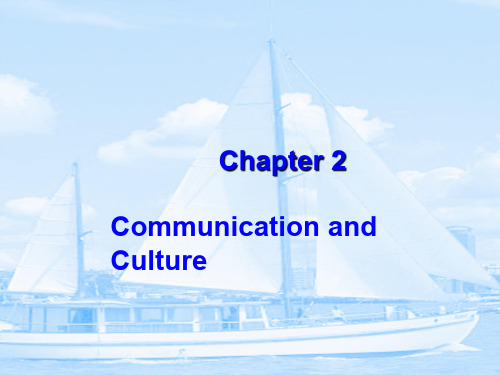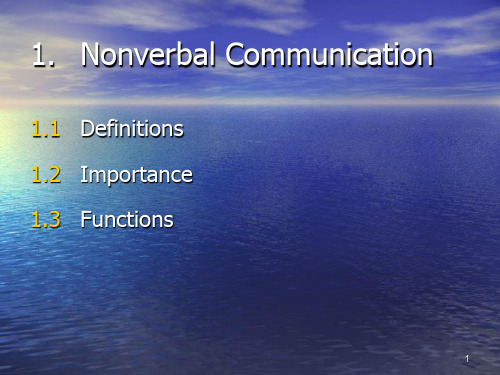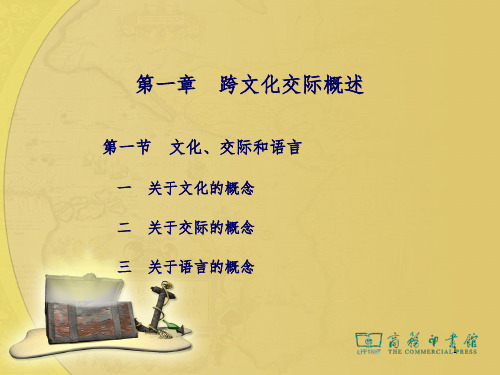跨文化交际导论课件2
合集下载
跨文化交际实用教程unit2课件ppt

适合营销广告管理公务员会计师建造师金融师经济师教师学生家长职员研究生养生家艺术家自然及社会学者娱乐者等各种人士阅读下载分享打印或收藏
Unit 2
Daily Communication (I)
Objectives
Learn the differnces of addressing people and greeting between Chinese and western culture.
Close Relationship/ Informal Situation
Surname+Title Surname+Title
Given Name
Title+Surname
Title+Surname Given Name Given Name
9
How to express fu +title?
16
Business visiting:
arrange a time in advance some straight to the point
Social visiting:
more flexible
I’m coming to see you this afternoon.
17
Some suitable expressions:
6
Decide the following addresses are right or not.
He Xiangu
Andrew Lቤተ መጻሕፍቲ ባይዱwis
He xiansheng He Xiangu Xiangu Gu He jingli He tongzhi He xiaozhang He laoshi He yisheng
Unit 2
Daily Communication (I)
Objectives
Learn the differnces of addressing people and greeting between Chinese and western culture.
Close Relationship/ Informal Situation
Surname+Title Surname+Title
Given Name
Title+Surname
Title+Surname Given Name Given Name
9
How to express fu +title?
16
Business visiting:
arrange a time in advance some straight to the point
Social visiting:
more flexible
I’m coming to see you this afternoon.
17
Some suitable expressions:
6
Decide the following addresses are right or not.
He Xiangu
Andrew Lቤተ መጻሕፍቲ ባይዱwis
He xiansheng He Xiangu Xiangu Gu He jingli He tongzhi He xiaozhang He laoshi He yisheng
跨文化交际概述PPT课件

• A: Okay, thanks for the information, Let’s get together soon.
• B: I’d love to. • A: Good, I’ll give you a call and we’ll make a date for
lunch. • B: If you want, we can make a date now. When are
• 大众交际(mass communication)一般定义为职业化 的传播机构利用机械化、电子化的技术手段向不特定 的多数人传送信息的行为或过程。
三、交际的要素
• 一个完整的交际过程包含了九项要素: 传送者、制码、讯息、通道、接收者、 解码、回馈、环境及噪音。
四、交际的模式
• 语言是人类最重要的交际工具。 • 语言是人类最重要的思维工具。 • 语言是文化的载体。
农民peasant 龙dragon
凤凰phoenix 猫头鹰owl
孔雀peacock 狗dog
• A、B概念意义相同,A有内涵意义,B无内涵意 义
松柏鹤桃 pine /cypress/crane/peach 梅兰竹菊plum
blossom/orchid/bamboo/chrysanthemum 数字
二、交际的种类
• 内向交际(intrapersonal communication)指一个 人自己脑子里在自我交流活动或是自言自语。
• 人际交际(interpersonal communication)两个人 或两个人以上的信息传受过程。
• 组织交际(organizational communication)在学校、 公司、工厂、机关、军队、党派、群众团体等内部的 传播是组织交际。
跨文化交际导论(英文版)(第二版) Chapter 2 communication and culture

The Selected Scene ---Conflicts Across Border
Task:
(1) Is there an effective communication between Santiago and the police?
(2) What caused the conflicts between them and how to avoid such conflicts?
Decode
Physical
Message Channel
Channel Message Feedback
Encode Receiver
Encode
Reasons for Misunderstanding
Encoding & Decoding
Not all communication could
Section 2 1. Basics of Communication
Warm-up questions
What is communication? How would two people in love let each
other know about their feelings? How many Chinese words can you
通信
传通
1.1 Definition of Communication
Communication
Latin word “communicare”
Act and process of sending and receiving messages among people
Means of Communication
跨文化交际PPT 2-5

Questions for Team B: When did your grandfathers retire? What do they do after retirement?
Sample: Survey report
A: According to our survey, most of the grandfathers have already retired. Of the people we polled, 85% said so. And 90% think that they shouldn’t go to work any more. The figures we have show that of the people we polled, 70% said their grandfathers are still working. And 95% think they should do so.
B:
As the facts prove, among the people who responded to our poll, 80% of their grandfathers retired at the age of 60. After retirement, 85% choose to enjoy themselves at home, such as growing flower, playing chess or caring for the grandchildren. While 15% continue working on the same position or find another job.
2.5 Components of Culture Patterns
Sample: Survey report
A: According to our survey, most of the grandfathers have already retired. Of the people we polled, 85% said so. And 90% think that they shouldn’t go to work any more. The figures we have show that of the people we polled, 70% said their grandfathers are still working. And 95% think they should do so.
B:
As the facts prove, among the people who responded to our poll, 80% of their grandfathers retired at the age of 60. After retirement, 85% choose to enjoy themselves at home, such as growing flower, playing chess or caring for the grandchildren. While 15% continue working on the same position or find another job.
2.5 Components of Culture Patterns
跨文化交际PPT演示课件

23
3. Space and Distance
3.1 Proxemics 3.2 Attitudes Toward Crowding
24
3.1 Proxemics
✓ Definition: the study of people’s perception and use of space.
✓ Four categories: intimate, personal, social, and public distance.
26
Categories of Distance (cont’d)
• Social Distance (1.3-3m) - colleagues, business partners, people at social gatherings
• Public Distance (beyond 3m) - speaking in public
- direct intrusion into others’ affairs • Shrugging shoulders
- indifferent, powerless, having no secret to conceal
19
Postures (cont’d)
• Follow one’s natural habits so often go unnoticed (subconscious in nature)
• May damage your image if you neglect your postures
20
2.4 Eye Contact
Direct eye contact • Chinese: avoid • North Americans: appreciate • The British: avoid
3. Space and Distance
3.1 Proxemics 3.2 Attitudes Toward Crowding
24
3.1 Proxemics
✓ Definition: the study of people’s perception and use of space.
✓ Four categories: intimate, personal, social, and public distance.
26
Categories of Distance (cont’d)
• Social Distance (1.3-3m) - colleagues, business partners, people at social gatherings
• Public Distance (beyond 3m) - speaking in public
- direct intrusion into others’ affairs • Shrugging shoulders
- indifferent, powerless, having no secret to conceal
19
Postures (cont’d)
• Follow one’s natural habits so often go unnoticed (subconscious in nature)
• May damage your image if you neglect your postures
20
2.4 Eye Contact
Direct eye contact • Chinese: avoid • North Americans: appreciate • The British: avoid
跨文化交际第二PPT课件

13
文化定势的特征
首先,定势和归类有一定的联 系,是过分简单化的归类。 其次,定势有不可避免性 再者,定势具有稳定性和延续 性。
14
第一章 跨文化交际概述
第一节 文化、交际和语言
4、亚文化
在文化学研究领域,通常把文化分为主流文化和亚文化。 也就是说,文化的概念具有层次性,一种整体文化中往往包含 了各种不同的次范畴“变体”,形成某种文化圈内的亚文化圈。
3
第一章 跨文化交际概述
第一节 文化、交际和语言
后来“文化”一词被日语借入,到近代作为英 语culture的对译词。再后来“文化”作为日语借词 又被现代汉语吸收,于是“文化”就同英语的 culture有了直接的词源关系,并衍生出“文明”、 “教育”等含义。
4
什么是文化?
文化离不开 人,是某一 群体的生活 方式。
第一章 跨文化交际概述
第一节 文化、交际和语言
一 关于文化的概念 二 关于交际的概念 三 关于语言的概念
1
第一章 跨文化交际概述
第一节 文化、交际和语言
一 关于文化的概念
(一)文化的定义
1.中西文化探源
“文化”的概念古已有之,指与“武力”相对的文德教化。
圣人之治天下也,先文德而后武力。凡武之兴,为不服也;文化不
第一节 文化、交际和语言
在文化学或文化人类学中,“文化”一词通常指人
类社会区别于其他动物的全部活动方式以及活动的产品。
就这一概念的核心内涵而言,它的意义是明确的。然而
专家们给“文化”所下的定义可以说各有千秋。在众多
的关于文化的定义中,文化人类学家泰勒(Tylor)和马
林诺夫斯基(Malinowski)的定义比较受人推崇。前者
《跨文化交际》课件

2
基本规则
了解跨文化交际的基本规则,如注重非语言沟通、避免使用俚语和难懂的语言等方的文化背景和习惯,调整沟通策略,确保信息的准确传达。
解决跨文化交际中的问题
1 展示文化敏感性
在跨文化交际中,需要对不同文化背景的人 表示尊重和理解。
2 调整沟通策略
针对跨文化交际中遇到的问题,我们可以根 据对方的习惯和背景,调整沟通策略,解决 问题。
案例研究
跨文化交际成功案例
一位跨国公司的领导成功地进行了跨文化沟通,在 不同国家的员工中建立了良好的合作关系。
跨文化交际失败案例
因为文化差异,一个国际项目中的交流出现了误解 导致该项目未能按时完成。
总结与讨论
反思课程内容
通过本课程的学习,您是否更好地了解了跨文化交际的重要性和技巧?
提出问题和建议
《跨文化交际》PPT课件
本课程旨在帮助您更好地了解跨文化交际的重要性和技巧,并掌握如何有效 地与不同文化背景的人交流。
什么是跨文化交际?
定义
跨文化交际是指在跨越不同文化背景的情况下进行的交流和互动。
重要性
随着全球化进程的加快,跨文化交际的重要性越来越受到重视。
挑战
不同文化之间的交流可能会面临很多挑战和障碍,需要我们采取有效的沟通策略。
在跨文化交际的实践中,您是否遇到了问题?为了更好地提高跨文化交际的能力,您有什么 建议?
文化差异
不同的文化特征
每个文化都有自己独特的特征,例如语言、信仰、 价值观和习俗。
文化差异的影响
文化差异可能会影响人们的观念、行为和与他人的 交流方式。
文化融合
跨文化交际也是文化融合的过程,可以促进不同文 化之间的理解和尊重。
跨文化沟通技巧
《跨文化交际》课件

尊重他人
尊重和接受不同文化的观点 和做法。
发展人际关系
建立良好的人际关系有助于 跨文化交际的顺利进行。
结论和总结
跨文化交际是一个复杂而有趣的领域,它可以丰富我们的视野,增进人与人之间的理解和合作。在全球化的时 代,跨文化交际的重要性不可忽视。
自由民主
西方社会价值观的核心之一,强调个人自由和人权。
摇滚音乐
西方音乐文化的代表,让人们释放情感和表达自我。
跨文化交际的概念
跨文化交际是指不同文化背景的人之间进行有效沟通和交流的过程。
跨文化交际的重要性
1 提高理解力
通过跨文化交际,我们能够更好地理解和尊重他人的文化。
2 促进合作
跨文化交际有助于不同文化背景的人们共同合作解决问题。
《跨文化交际》PPT课件
跨文化交际是研究不同文化间的交流,了解和尊重不同文化背景的重要性。
中国文化
长城
茶道
中国古代的伟大建筑物,象征着 中国的辉煌历史和文化的丰富性。
中国独特的文化艺术,展示了对 礼仪和和谐的追求。
书法
中国的艺术形式,以笔刷和墨水 书写汉字,传承了上千年的历史。
西方文化
圣诞节
西方重要的节日,在这一天人们庆祝和分享快乐。
3 推动创新
不同文化间的交流和碰撞能够激发创新思维,产生新的想法和解决方案。
跨文化交际中的挑战
1
语言障碍
不同语言之间的差异可能导致交流困难。
2
文化差异
不同文化的价值观和习俗可能造成误解和冲突。
3
沟通风格
跨文化交际中的沟通方式和风格可能不同,需要灵活适应。
跨文化助于更好 地交流和理解。
跨文化交际概论 ppt课件

ppt课件
3
第一章 跨文化交际概述
第一节 文化、交际和语言
在文化学或文化人类学中,“文化”一词通常指 人类社会区别于其他动物的全部活动方式以及活动的 产品。就这一概念的核心内涵而言,它的意义是明确 的。然而专家们给“文化”所下的定义可以说各有千 秋。在众多的关于文化的定义中,文化人类学家泰勒 (Tylor)和马林诺夫斯基(Malinowski)的定义比较 受人推崇。前者着眼于文化的整合性和精神性,后者 着眼于文化的功能性和制度性。
ppt课件
9
第一章 跨文化交际概述
第一节 文化、交际和语言
在文化学研究领域,通常把文化分为主流文化和亚文化。 也就是说,文化的概念具有层次性,一种整体文化中往往包含 了各种不同的次范畴“变体”,形成某种文化圈内的亚文化圈。
亚文化产生于亚群体,亚群体是某个民族内部的群体分化, 他们在亚群体中享有共同的信仰、价值观、行为准则、交往规 范以及认知模式。不同亚群体之间在所觉、所思、所言、所为 等方面都存在一定的差异,因此,亚文化与主流文化之间,既 有“大同”的一面,也有“小异”的一面。
广义:指人类在历史发展中所创造的物质财富 和精神财富的总和。
在通常情况下,提到“文化”人们首先想到的 是它的狭义方面,即文化的精神形态方面。
ppt课件
8
第一章 跨文化交际概述
第一节 文化、交际和语言
2 .文化定势
世界上大多数社会中都可能存在着若干群体或社团,这 些群体或社团对地域、历史、生活方式以及价值观等方面的共 享,使其成员形成、发展并强化了自己独特的文化及与之相适 应的交际文化。在跨文化交际研究中,学者们往往倾向于把某 一文化群体的每一个成员都视为该文化定势的代表或整体文化 形象。这种整体式的文化取向通常被称为文化定势。
跨文化交际(全套课件255P)

• 与美国人在一起,就照美国人的方式、习俗去说话、办事;与中国人在一起, 就按中国人的习俗来做。
2021/6/6
第二语言教学的主要目标是培养学生的跨文化交际能力。
• 跨文化交际能力指的是跨文化交际环境中的交际能力,即来自不同文化背景的 人之间进行交际时,具有强烈的跨文化意识,善于识别文化差异和排除文化干 扰并成功地进行交际的能力。是在跨文化交际环境中由语言交际能力、非语言 交际能力、语言规则和交际规则转化能力以及文化适应能力所组成的综合能力。
2. 文化不是先天所有,而是通过后天习得的。
文化共性:即人类的共性。人类文化共性是主要和基本的。文化 共性构成各种文化之间交际和共存的基础。
文化个性:长期的历史积淀形成了不同的文化个性。文化差异造 成了跨文化交际的障碍。
2021/6/6
文化的特性
1. 文化是人类所独有的,是区别人类和动物的主要标志。文化是社会遗产,而 不是生理的遗传。
2021/6/6
第二语言教学中需要处理好三种关系
1. 课堂教学与课外交际之间的关系,包括课本语言教学与课外应用指导之间的 关系。
2. 第二语言教学与第二文化教学之间的关系。 3. 培养学生的语言交际能力和培养他们的跨文化交际能力之间的关系。
你喜欢我们的日程安排吗?How do you like our schedule?
2021/6/6
文化的特性
• 文化是人类所独有的,是区别人类和动物的主要标志。文化是社会遗产,而不 是生理的遗传。
春雨惊春清谷天,夏满芒夏暑相连, 秋处露秋寒霜降,冬雪雪冬小大寒。
2021/6/6
文化的特性
1. 文化是人类所独有的,是区别人类和动物的主要标志。文化是社会遗产,而 不是生理的遗传。
2021/6/6
第二语言教学的主要目标是培养学生的跨文化交际能力。
• 跨文化交际能力指的是跨文化交际环境中的交际能力,即来自不同文化背景的 人之间进行交际时,具有强烈的跨文化意识,善于识别文化差异和排除文化干 扰并成功地进行交际的能力。是在跨文化交际环境中由语言交际能力、非语言 交际能力、语言规则和交际规则转化能力以及文化适应能力所组成的综合能力。
2. 文化不是先天所有,而是通过后天习得的。
文化共性:即人类的共性。人类文化共性是主要和基本的。文化 共性构成各种文化之间交际和共存的基础。
文化个性:长期的历史积淀形成了不同的文化个性。文化差异造 成了跨文化交际的障碍。
2021/6/6
文化的特性
1. 文化是人类所独有的,是区别人类和动物的主要标志。文化是社会遗产,而 不是生理的遗传。
2021/6/6
第二语言教学中需要处理好三种关系
1. 课堂教学与课外交际之间的关系,包括课本语言教学与课外应用指导之间的 关系。
2. 第二语言教学与第二文化教学之间的关系。 3. 培养学生的语言交际能力和培养他们的跨文化交际能力之间的关系。
你喜欢我们的日程安排吗?How do you like our schedule?
2021/6/6
文化的特性
• 文化是人类所独有的,是区别人类和动物的主要标志。文化是社会遗产,而不 是生理的遗传。
春雨惊春清谷天,夏满芒夏暑相连, 秋处露秋寒霜降,冬雪雪冬小大寒。
2021/6/6
文化的特性
1. 文化是人类所独有的,是区别人类和动物的主要标志。文化是社会遗产,而 不是生理的遗传。
跨文化交际导论Chapter2第一部分

Answer the following questions:
1. In the movie, how many things did Sara do in order to test fate? And what are they?
What do you think of these behaviors?
main contents
functions of communication and culture; components of communication and culture; characteristics of communication and culture.
2012/8/18
How does communication work?
2012/8/18
Dou Weilin: Introduction to ICC
10
eight components in communication processes
Message sender/encoder Encoding (编码)(the sender’s process of putting a
2012/8/18
Dou Weilin: Introduction to ICC
3
How many Chinese words can you think of that are used to express communication?
Communication
交际
交流
交往
沟通
传播
通信
传通
2012/8/18
Sara: strongly believes in destiny (命运)
跨文化交际(精品课件)

15
A Monumental Figure
• Edward Twitchell Hall, (1914 –2009) , American anthropologist and cross-cultural researcher.
• Hall introduced a number of new concepts, including proxemics, polychronigh and low context cultures.
Cross-cultural communication refers to any communication between two members of any cultural communities. (Samovar and Porter, 2004:47)
11
Cross-cultural Communication Vs
his Linguistic Across Cultures(《跨文化语言学》). He discussed the cultural comparison in three aspects: form, meaning and distribution(顾嘉祖,4). • In 1959,the Silent Language by Edward T. Hall initiated the cross-cultural studies. • R.Oliver , 1962, Culture and communication • A.G.Smith, 1966,Culture and communication • In 1970s, ICA (International Communication Association) accepted Cross-cultural Communication as a branch discipline. as a discipline) • Journals: International and Intercultural Journal of Intercultural Relations.
A Monumental Figure
• Edward Twitchell Hall, (1914 –2009) , American anthropologist and cross-cultural researcher.
• Hall introduced a number of new concepts, including proxemics, polychronigh and low context cultures.
Cross-cultural communication refers to any communication between two members of any cultural communities. (Samovar and Porter, 2004:47)
11
Cross-cultural Communication Vs
his Linguistic Across Cultures(《跨文化语言学》). He discussed the cultural comparison in three aspects: form, meaning and distribution(顾嘉祖,4). • In 1959,the Silent Language by Edward T. Hall initiated the cross-cultural studies. • R.Oliver , 1962, Culture and communication • A.G.Smith, 1966,Culture and communication • In 1970s, ICA (International Communication Association) accepted Cross-cultural Communication as a branch discipline. as a discipline) • Journals: International and Intercultural Journal of Intercultural Relations.
跨文化交际Unit-2第二讲PPT课件

chapter13chapterinterculturalcommunicationg霍夫斯坦德教授是社会人文学博士曾主管过ibm欧洲分公司的人事调查工作荷兰马城maastricht大学国际管理系名誉教授在欧洲多所大学任教并担任香港大学荣誉教授从事组织机构人类学和国际管理organizationalanthropologyinternataionalmanagement
2021/3/12
6
Chapter 1 Culture and Intercultural Communication
(2) How do you think of “self-reliance”?
• The American Creed is something of a doubleedged sword: it fosters a high sense of personal responsibility, independent initiative, and voluntarism ; it also encourages self-serving behavior, atomism, and a disregard for communal good. More specifically, its emphasis on individualism threatens traditional forms of community morality, and thus has historically promoted a particularly virulent strain of greedy behavior”
• Play a role • To feel an obligation toward
2021/3/12
2021/3/12
6
Chapter 1 Culture and Intercultural Communication
(2) How do you think of “self-reliance”?
• The American Creed is something of a doubleedged sword: it fosters a high sense of personal responsibility, independent initiative, and voluntarism ; it also encourages self-serving behavior, atomism, and a disregard for communal good. More specifically, its emphasis on individualism threatens traditional forms of community morality, and thus has historically promoted a particularly virulent strain of greedy behavior”
• Play a role • To feel an obligation toward
2021/3/12
跨文化交际概论课件

第五章
一 二 三
跨文化语用对比分析
第一节 语言使用的文化差异
社会语言差异 合作原则及其文化差异 礼貌原则及其文化差异
第二节 言语行为的文化差异
一 二 三 言语行为理论 语言表达的间接性 言语行为的文化差异分析
第六章
第一节
一 二 三
跨文化语篇对比分析
跨文化语篇差异的相关研究
语篇及其相关概念 语篇的文化差异研究 语篇差异与语境因素
角色概念 角色关系 角色关系的变量
第二节 人际关系与跨文化交际
一 二 三 人际关系及其制约因素 人际关系的文化对比分析 人际关系取向及其类型
第四章
第一节
一 二 三
规范系统与文化过滤
行为与规范系统
关于规范和规则 规范和规则系统 规范系统的文化冲突
第二节
一 二 三
代码与文化过滤
文化过滤及代码系统 明指意义和暗涵意义 句法意义和认知意义
第一节
一 二
性别差异、性别歧视 与跨文化交际
性别差异及跨性别交际
性别文化与性别角色 性别差异与交际规范
三
跨性别交际的文化冲突
第二节
一
二
性别歧视与跨文化交际
女权运动与语言性别歧视研究
性别歧视现象在语言中的表现
三
语言性别歧视与跨文化交际
第二节
一 二
语篇结构差异的对比分析
汉语和英语的语篇结构差异 语篇结构差异的相对性
第七章
第一节
一 二
非言语行为差异与跨文化交际
非言语行为的类型与功能
非言语行为的类型 非言语行为的功能
第二节
非言语行为的文化差异
一 身姿语的文化差异 二 手势语的文化差异 三 表情语的文化差异 四 体距语的文化差异
- 1、下载文档前请自行甄别文档内容的完整性,平台不提供额外的编辑、内容补充、找答案等附加服务。
- 2、"仅部分预览"的文档,不可在线预览部分如存在完整性等问题,可反馈申请退款(可完整预览的文档不适用该条件!)。
- 3、如文档侵犯您的权益,请联系客服反馈,我们会尽快为您处理(人工客服工作时间:9:00-18:30)。
Further Explanation
There are at least two or more people: In terms of who communicate with whom, whether it being human, animals or machines, the classification is as follows: Human communication Animal communication Human-animal communication Human-machine communication Machine-to-machine communication
Further Explanation
There is a language shared between communicators.
Human language
Verbal
Nonverbal
Non-word sounds
Body language
e.g. Chinese, English
e.g. Sounds uttered to control
III. The Classification of Communication
Communication occurs when – there are at least two or more people. there is some contact between communication. there is a language shared by communicators. there is an exchange of information that has taken place.
Fundamentals of Intercultural Communication
Chapter 2
Chapter 2: Basic Communication Theories
I. II.
III. IV.
V. VI.
Communication defined Needs and Functions of communication 1. Maslow’s hierarchy of needs 2. Functions of communication The classification of communication The process of communication 1. Components of communication 2. Models of communication The characteristics of communication The challenge of effective communication in interpersonal encounters
e.g. Braille
e.g. Logic animals
e.g. Computer
Fig. 2-3 Language for Communicating (Artificial Language)
Further explanation
There is an exchange of information that has taken place. Various degrees of success in communication, ranging from - complete success, - partial success to - failure.
Definition of “Communication”
Samovar and Porter’s (1997) definition: “Communication occurs whenever meaning is attributed to behavior or the residue of behavior.” (p.9) It means when someone perceives our behavior or its residue and attributes meaning to it, communication has taken place regardless of whether our behavior was conscious or unconscious, intentional or unintentional. e.g. tapping one’s fingers
II. Needs and Functions of Communication
1. Maslow’s hierarchy of needs
Self-actualization needs (self-development and realization) Esteem needs (self-esteem, recognition, status) Social needs (sense of belonging, love) Safety needs (security, protection) Physiological needs (hunger, thirst)
2. Functions of communication
Practical function: e.g. buying food, renting an apartment, securing a job, etc. Social function: to meet others, establish ties, maintain friendships, etc. Decision making function: We use information to decide what job to take, where to live, and who to marry, etc. Personal growth function: Through self-expression and feedback from others, we define and confirm who we are, feel appreciated and successful, obtain new information, increase our level of selfawareness, and expose ourselves to challenging new experiences. As a result, we grow up.
e.g. Gestures, head பைடு நூலகம்ovements
Fig. 2 – 3 Language for Communicating (Human language)
Further explanation
Artificial Language
Special purpose
Symbolic
Machine
Samovar and Porter’s Approach
Therefore, Samovar and Porter’s approach to communication has focused on the behavior of one individual causing or provoking a response from another by the attribution of meaning to behavior. These various meanings have developed throughout our lifetime as a result of our culture acting upon us as well as the result of our individual experiences within that culture.
Further Explanation
Attribution means that we draw upon our past experiences and give meaning to the behavior that we observe. Residue refers to those things that remain as a record of our actions. e.g. smoking in the elevator and the odor
Fig. 2-2 Classification of Communication
Further Explanation
There is some contact between communicators. Two-way contact: communicators can see each other and monitor each other’s behavior – direct communication; One-way contact: communicators cannot see each other, and hence cannot monitor each other’s behavior. So, communication can also be divided into direct communication vs. indirect communication, face-to-face communication and distance communication.
Classification of Communication
Communication Human ~ Non-social ~ Social ~
Biological/ physical ~
Intra-personal ~
Interpersonal ~
Organizational ~
Mass ~
